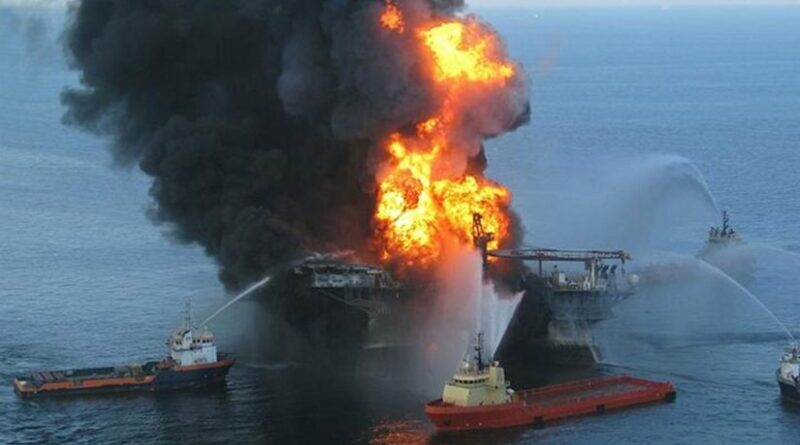Continuing Impacts Of Deepwater Horizon Oil Spill
Nine years ago –April 20, 2010–crude oil began leaking from the Deepwater Horizon drilling rig into the Gulf of Mexico in what turned out to be the largest marine oil spill in history. A long-term study suggests the oil is still affecting the salt marshes of the Gulf Coast, and reveals the key role that marsh grasses play in the overall recovery of these important coastal wetlands.
Conducting the study was a multi-institutional research team funded in part by the Gulf of Mexico Research Initiative, a 10-year independent program established through a $500 million financial commitment from BP. The team began sampling soon after the spill was finally contained, and continue their work today. Their most-recent article–in Estuaries and Coasts–reports on the first six and a half years of sampling post-spill.
Lead author on the study is John Fleeger, an emeritus professor at LSU. Co-authors are Rita Riggio, Irving Mendelssohn, Qianxin Lin, and Aixin Hou of LSU; David Johnson of William & Mary’s Virginia Institute of Marine Science; Donald Deis of Atkins North America; Kevin Carman of the University of Nevada-Reno; Sean Graham of Nicholls State University; and Scott Zengel of Research Planning, Inc.
Johnson, an assistant professor at VIMS and expert in salt marsh invertebrates, says “Our study highlights the crucial role that plants play in the recovery of important links in the Gulf of Mexico’s coastal food web.” Those links ultimately connect to the fish and shellfish that support the region’s economy and culture.
Two plants dominate healthy Gulf Coast salt marshes–the smooth cordgrass Spartina alterniflora and the black needlerush Juncus roemerianus. Also abundant on the marsh surface are single-celled, plant-like organisms that scientists collectively refer to as benthic microalgae, while a suite of small invertebrates–amphipods, copepods, nematodes, snails, worms, and others–swim, hop, and crawl among the grass blades or burrow in the underlying root zone.
The team studied these organisms by measuring their abundance and biomass in heavily oiled, moderately oiled, and oil-free areas of Louisiana’s Barataria Bay, using both surface plots and shallow cores. Sampling took place at roughly 6-month intervals between 2011 and 2016.
The researchers’ early sampling showed that nearly all the plants in heavily oiled areas died, while benthic microalgae and burrowing invertebrates suffered significant reductions. Their later sampling showed that marsh recovery was led by benthic microalgae and Spartina–which began to show significant above-ground growth within two to three years.
Importantly, it was only after Spartina started its comeback that recovery of the invertebrate community began in earnest. “Plants are the foundation of salt marshes,” explains Johnson. “Marsh grasses facilitate colonization by burrowing invertebrates; fuel the food web, provide animal habitat, bind the soil, and slow water flow. Without plants there is no marsh, and there is no marsh recovery following a spill without plants leading the way.”
If you plant it, they will come
The team’s findings have important implications for responding to any future spills. Fleeger says “our findings indicate that mitigation strategies for any future spills should include the planting of foundation species such as Spartina.”
Mendelssohn, a VIMS alumnus (M.A. ’73), says that foundation species “enhance recovery by providing habitat and reducing sediment erosion.” Over the longer term, he says, “plant growth enhances recovery by improving soil quality. Plants generate organic matter that accumulates belowground, while their roots and rhizomes release oxygen, bind sediments, and increase sediment volume. Breakdown of plant tissues also provides nutrients that further stimulate plant growth and beneficial microbial processes in the marsh.”
A slow road to full recovery
Tempering the promise of marsh recovery via planting of grasses such as Spartina is the team’s discovery that heavily oiled marsh sites remained less healthy than moderately oiled and oil-free sites more than 6 years after the Deepwater Horizon spill. Heavily oiled sites still had elevated concentrations of oil and its breakdown products, and showed slower growth of black needlerush, lower production of plant detritus and below-ground organic matter, and altered soil density. Populations of worms, juvenile snails, and other small invertebrates had also failed to fully recover.
Particularly troubling was the continued rarity of the polychaete worm Manayunkia aestuarina. One of the most abundant single species in the invertebrate community, this tube dweller is important to the health of marsh sediments, and plays a key role in the marsh food web as a major prey item for crabs, shrimp, and fish. “The near absence of this species could indicate significant alteration of ecological function at heavily oiled sites,” says Johnson.
Also troubling is that projecting the observed pace of mash recovery into the future suggests that complete recovery at moderately and heavily oiled sites will likely take much longer than a decade. This is slower than reported in many previous studies of oil spills and their impacts on the marsh community.
“Previous work shows that oil spills in salt marshes can impact bottom-dwelling invertebrates for more than four decades,” says Fleeger. “Long-term exposure to oil and its breakdown products may also decrease the sensitivity and resilience of these organisms to future spills,” he adds.
On a brighter note, a previous study by Johnson and colleagues suggests that fertilization of Spartina plantings can enhance growth of both its stems and roots, thus aiding marsh recovery in the long term. “We’re starting to see the salt marsh in the Gulf of Mexico rebound,” says Johnson, “but it will likely be a decade or more before we see complete recovery.”

